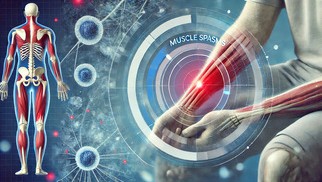Muscle Spasms: Causes, Symptoms, and Effective Treatments


Muscle spasms, commonly referred to as cramps, are involuntary contractions of a muscle or group of muscles. These episodes can occur suddenly and may vary in intensity, from mild discomfort to severe pain. While often temporary, muscle spasms can disrupt daily activities and signal underlying health issues in some cases. In this article, we will explore the nature of muscle spasms, their causes, treatments, and address common concerns, such as whether anxiety can trigger muscle twitching.
What Does a Muscle Spasm Feel Like?
The sensation of a muscle spasm is often described as a sudden tightening or knotting of the muscle. This can feel like a sharp, stabbing pain or a persistent cramp that immobilizes the affected area. The muscle may appear visibly hard or tense during the spasm and can sometimes even form a noticeable lump under the skin. Depending on the location, a muscle spasm can hinder mobility, such as making it difficult to walk if it occurs in the leg or affecting grip strength if it involves the hands.
For many people, the discomfort resolves within minutes, leaving behind a feeling of soreness or fatigue in the affected muscle. However, in some cases, the spasm may persist for longer or recur frequently, suggesting an underlying condition that requires medical attention.
What Causes Muscle Spasms?
Muscle spasms can result from a variety of factors, ranging from lifestyle habits to medical conditions. Some of the most common triggers include:
- Dehydration and Electrolyte Imbalances Inadequate hydration or a deficiency in key electrolytes, such as potassium, magnesium, or calcium, can disrupt muscle function, leading to spasms. This is especially common in athletes or individuals who perform strenuous physical activity without replenishing fluids and nutrients.
- Muscle Overuse or Fatigue Prolonged or intense exercise can overwork muscles, causing them to cramp. This is particularly common in activities like running, cycling, or weightlifting when the muscles are not adequately warmed up or stretched beforehand.
- Poor Circulation Reduced blood flow to muscles, often due to sitting or standing in one position for too long, can lead to cramping. Conditions such as peripheral artery disease (PAD) may also contribute to circulation-related spasms.
- Stress and Anxiety High levels of stress and anxiety can lead to muscle tension and spasms, particularly in the neck, shoulders, and back. These spasms may be accompanied by other symptoms, such as headaches or jaw clenching.
- Medications Certain medications, such as diuretics, statins, or those that affect electrolyte balance, can increase the likelihood of muscle cramps as a side effect.
How Can You Fix a Muscle Spasm?
Treating muscle spasms often involves a combination of immediate relief measures and long-term strategies to prevent recurrence.
Immediate Relief
- Stretching and Massage: Gently stretching the affected muscle can help release the contraction and reduce pain. For example, if the spasm is in the calf, flexing your foot upward toward your shin can alleviate the cramp. Massaging the area with firm but gentle pressure can also promote relaxation and improve blood flow.
- Heat or Cold Therapy: Applying a warm compress or heating pad to the affected area can help relax the muscle and alleviate tension. For spasms caused by inflammation, a cold pack can help reduce swelling.
- Hydration: Drinking water or an electrolyte-rich beverage can help restore balance and relieve spasms caused by dehydration.
Preventive Measures
- Regular Stretching and Exercise: Incorporating stretching into your daily routine can improve muscle flexibility and reduce the likelihood of spasms. Low-impact exercises like yoga or Pilates are excellent for promoting muscle health and circulation.
- Balanced Diet: A diet rich in minerals such as potassium (found in bananas and spinach), magnesium (in nuts and seeds), and calcium (in dairy products or leafy greens) supports healthy muscle function.
- Manage Stress: Practicing stress-management techniques such as mindfulness, meditation, or deep breathing exercises can reduce muscle tension and lower the risk of stress-related spasms.
Can Anxiety Cause Muscle Twitching?
Yes, anxiety can contribute to muscle twitching. When the body experiences stress, it releases hormones like adrenaline, which can cause muscles to tense up or twitch. These involuntary twitches, known as fasciculations, are often harmless and occur in areas such as the eyelids, face, or limbs.
Chronic anxiety can lead to persistent muscle tension, making spasms or twitches more frequent and noticeable. Addressing the underlying anxiety through therapy, relaxation techniques, or prescribed medications can significantly reduce these symptoms. However, persistent or severe twitching should be evaluated by a doctor to rule out other potential causes, such as neurological disorders.
Treatment with Robaxin for Muscle Spasms
Robaxin (methocarbamol) is a prescription muscle relaxant commonly used to treat muscle spasms and related discomfort. It works by targeting the central nervous system to reduce muscle contractions, helping to relieve pain and stiffness. Unlike some other muscle relaxants, Robaxin does not act directly on the muscles themselves but rather alters the signals sent by the nervous system, allowing the muscles to relax more effectively.
Robaxin is often prescribed for conditions such as acute muscle spasms, back pain, or injuries like strains and sprains. It is particularly effective when combined with other treatments, such as physical therapy, rest, and ice or heat application. Patients typically notice relief within 30 minutes to an hour after taking the medication, making it a fast-acting option for managing painful spasms.
While generally well-tolerated, Robaxin can cause side effects, including drowsiness, dizziness, or an upset stomach. It’s important to follow a doctor’s instructions regarding dosage and avoid alcohol or operating heavy machinery while taking this medication. Robaxin is not intended for long-term use and should be part of a broader treatment plan that addresses the underlying causes of muscle spasms.
Muscle Cramps Treatment
If muscle spasms are recurring or severe, it may be necessary to explore more targeted treatments, especially when an underlying medical condition is present. Some options include:
- Physical Therapy: A physical therapist can design a personalized program to strengthen and stretch the affected muscles, address posture issues, and prevent future spasms.
- Prescription Medications: In some cases, doctors may prescribe muscle relaxants like Robaxin or antispasmodic medications to manage chronic spasms.
- Alternative Therapies: Some individuals find relief through alternative methods, such as acupuncture, chiropractic care, or herbal remedies.
When to Seek Medical Attention
While most muscle spasms are harmless and self-limiting, certain signs warrant a visit to a healthcare provider. These include:
- Spasms that are severe, frequent, or persist for an extended period.
- Accompanying symptoms such as weakness, numbness, or swelling.
- A history of chronic medical conditions like diabetes or nerve disorders.
Conclusion
Muscle spasms can be a frustrating and painful experience, but understanding their causes and taking proactive measures can significantly reduce their impact. Whether triggered by dehydration, overuse, or stress, addressing the root causes is key to long-term relief. If anxiety is contributing to muscle twitching, adopting stress-reduction strategies can be highly beneficial. For persistent or severe symptoms, seeking professional medical advice is crucial.
Taking care of your muscles through proper hydration, nutrition, and regular exercise is an investment in your overall well-being, ensuring that you can move through life with comfort and ease.
Article post: Editorial Team of RXShop.md
(Updated at Jan 22 / 2025)

